Hey. You wanna know a secret? It’s a doozy.
You don’t have a pacemaker or anything? All right. Get the children out of the room.
Come closer.
Closer.
…I didn’t really care for Shovel Knight.
Part 1: The Part That Isn’t about Freedom Planet
If you’ve somehow managed to avoid the colossal Shovel Knight circle jerk, I’ll give you the highlights. It began as a Kickstarter project and quickly gained boatloads of attention. Ultimately, it wound up becoming a wildly successful platformer. It seemed to get more praise than Dark Souls 2, Shadows of Mordor, and Dragon Age: Inquisition combined. I’d argue it was the best-loved game of the year. Hardly anyone said anything bad about it. And I don’t just mean that no one wrote a bad or even mediocre review of the game. I mean nobody so much as included a throwaway criticism at the end of the body of their reviews. I can hardly think of another game that is so universally lauded as being perfect, which is outright misguided.
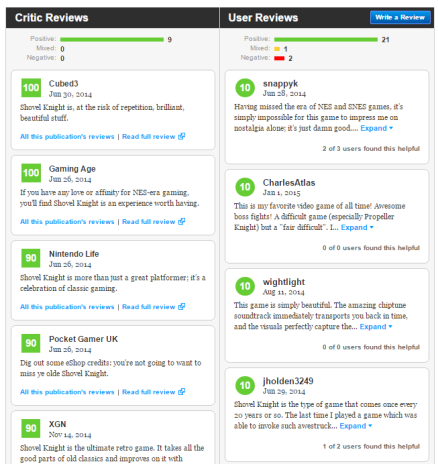
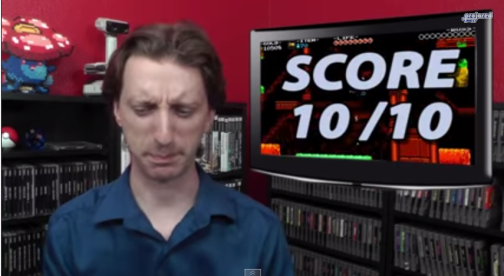
I’ll openly admit a lot of my disdain for Shovel Knight stems from the fact that people have treated it like a masterpiece. I did enjoy parts of the game. The bosses, for one, are some of the best I’ve ever seen in a sidescroller. I really love the one with Polar Knight. He has some really creative projectiles, and I love the joke of having a snow shovel. His fight manages to feel like a spar against your equal without lazily using a dopplegänger or someone with roughly your capabilities. In addition, the boss rush at the end of the game is, in my opinion, the highlight of the entire game.
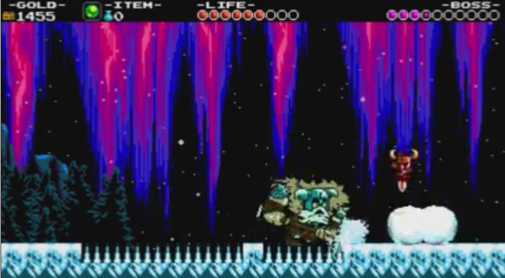
But aside from boss design, it’s fairly mediocre as far as retro-modern indie platformers go. The game is supposed to be an amalgam of everything you loved about classic of the NES library. It tries to take the impeccable level design of Mega Man; the gameplay of DuckTales; the mechanical implementation, structure, and world map of Mario 3; and the subweapons and aesthetic of Castlevania. Unfortunately, it doesn’t do any of those things as well as the games that inspired it. The levels and control aren’t as crisp as they are in Mega Man, the spirit of Castlevania isn’t preserved, and the subtleties of Mario 3 are simply ignored. It’s bad enough that people think this game is hot shit. I’ve seen people who go so far as to say it’s better than any of those other games. There’s no way it is.

Shovel Knight drives over a lot of the same potholes as Mega Man, but it swerves into them rather than trying to veer away. There are far too many bottomless pits, and too often, the game substitutes challenging platforming with attempts to knock you into the void. This problem is accentuated by a respawn system that clones Demon’s Souls. You have to reclaim your money after you die, which, too often, is impossible because it’s three inches above a pit.
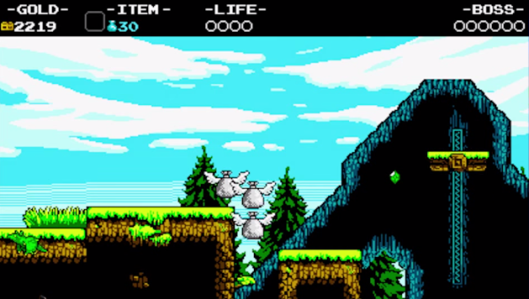
There are plenty of times when what you’re supposed to do is conveyed poorly. I remember one time when I was given about one quarter-second to realize that I can break the totally solid wall in front of me before the torpedo I was standing on decided to go ahead and meet up with me later. I also remember a part where I instinctively held down when panning to a lower screen and died because my clairvoyance hadn’t informed me breaking through the block below me would kill me instantly. Mega Man isn’t entirely free of these kinds of blunders, but it’s also a franchise that’s ten times longer, and every installment to the series has come out before Shovel Knight was even in development. There’s too much sloppiness in Shovel Knight‘s design.
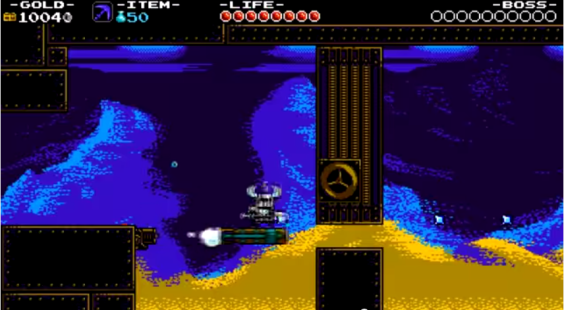
The control isn’t quite as fluid as it is in DuckTales.. Once you start bouncing on top of things, you’re trapped. You have to bounce up and down until you hit something unbreakable. I’m quite capable of moving my hand off a button when I want to stop, Yacht Club. Thanks anyway for the safeguard.
The items are basically useless here. In Castlevania, they could mean the difference between life and death. In Shovel Knight, they’re more of an… “oh, you know what? This might actually be a little bit easier with the fire wand, now that I think about it.” That’s another problem: the game is too easy. I played through the game on new game plus, and was never really met with much opposition. The only times I remember dying are the (still great!) boss fights and the bullshit moments of required fortune-telling. A lot of enemies block your attacks, but it’s easy to just jump over them and attack from a different angle. In Castlevania, you were rarely able to avoid confrontation so easily.
The most insulting comparison, of course, is to Super Mario Bros. 3. Shovel Knight tries to balance progressive/emergence as well as Mario 3, but it never does it quite as masterfully. Some mechanics only appear once or twice, and they never feel fully expanded upon. Almost everything only shows up in one single level as well. The brick-by-brick layout of the game is one of the few things I’ll say it succeeded at emulating. It doesn’t fit the gameplay quite as well as Mario 3, but it works pretty well, and makes smashing through blocks satisfying. The problem with this is that it leaves a lot of opportunity for “hiding” “secrets.” That’s right. We’re down the same rabbit hole we were in last time. Every secret is hidden in almost exactly the same manner. You have to blow up a block or jump along some platforms to blow up a block or bounce off something and blow up a block. Rarely, you’ll have to blow up the block before you kill an enemy or fall too far down the screen. It gets really repetitive, especially considering that the blocks are marked as explosive. This isn’t the same as rewarding a curious player’s journeys above the ceiling with warp zones. This isn’t even a matter of watching The Wizard and having the mental cognizance to follow someone else’s lead. It’s a matter of “can you see the block? Congratulations, here’s a big gem.” I know, in the last review, I said that DOOM did secrets right because anyone could find them, but that’s not entirely true. You actually needed to look in unusual places and think outside the box to find them. They were just put close enough to the side of the box that nobody had to infer some cryptic solution. Here, every secret is in plain view. It’s the difference between an Easter egg hunt and getting Christmas presents. On the flip side, Shovel Knight often presents the kind of mini-challenges Shadow Warrior needed more of. I’d have liked to see more of this. You’ll often find a quick platforming course in front of your song or gems or whatever. It does the thing I said I liked in games, so I’m kind of obligated to give it praise there. Dammit!
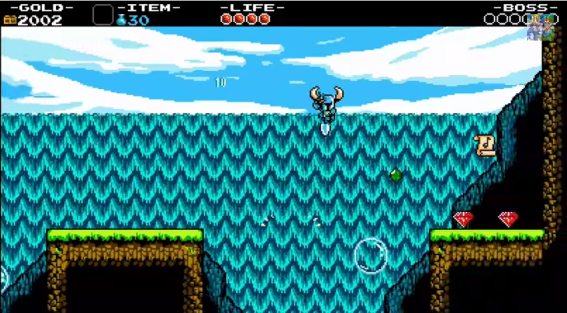
Also, as petty and small as it seems/is, the world map is a serious problem. No game is ever going to do one as well as Mario 3, and that was kind of by design. In Mario 3, the fun of the world map was the discovery of a new minigame or a spontaneous enemy encounter. It allowed you to take multiple paths, yet maintained the feel that you were progressing through a world. It posed clear goals to strive toward. Every game that has tried to do this has failed, which is a testament to how good Mario 3 is. In fact, the closest we’ve ever come to something this good was Super Mario World, because it was the same freaking thing. Shovel Knight‘s world map is barren and unnecessary. Half the spaces don’t even have anything on them. The only reason the game doesn’t progress in the same way a standard platformer or a Star Fox does is because it wants to have an adorable hub world. The game’s single town needs special address: it really only consists of a shop and a few hidden goodies, none of which are important enough to warrant the hub’s existence. Technically speaking, there are actually about four shops, but they could’ve just been consolidated into one screen. There’s no reason this village could not have been condensed into a pop-up screen or a quick little stand you’d encounter along your travels. This world map is just a waste of time and an attempt to give false depth to the game.
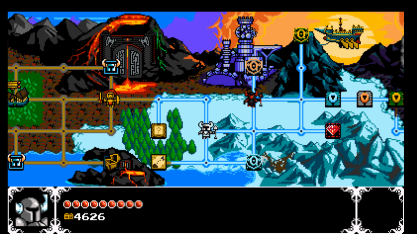
All of this probably wouldn’t bother me as much if people weren’t dead-set that this game is even close to being as good as those games. When people are audacious enough to say that Shovel Knight is better than Mega Man 3 or Castlevania 3 or Super Mario Bros. 3, I have to take up issue. I keep hearing people say that this game perfectly encapsulates the feeling of an eighties platformer without being as “bad” as one, and I’m surprised the Internet hasn’t been quick to scrutinize this praise. If this were anything else, people would have crucified anyone who posed such an argument as merely “putting on nostalgia goggles.” Why is it that generating artificial nostalgia gets a free pass? I’ve argued how good this game is a lot with fans, and the argument always goes the same way.
“Shovel Knight is great! It makes me feel like a kid again!”
“It’s not as good as Castlevania, you know.”
“What do you know, you’re just praising Castlevania because you played it when you were a kid.”
Right on, brother. Except, oh yeah, I only played Castlevania less than a year ago. Why is there a double standard that makes Mega Man 3 fans crotchety old-timers, while people who like Shovel Knight are real gamers? It’s always wrong to say something is objectively good because you, specifically, feel nostalgia toward it, whether you actually played the game when you were younger or not. It just so happens that Mega Man and Castlevania have things that are actually great about them, which makes them good for other reasons. You can’t say the same of Shovel Knight.
But even if this game was a shoddy version of the games it’s copycatting, even if I considered its nostalgia exploitation, even if I looked at all the things that are wrong with it, I might still have managed to get behind the game. The problem is that that’s all this game is. The magic of indie games is that they, for the first time, allow almost anyone to express themselves. Small developers are getting some of their first real chances to make the games they want to make and leave their signature on the market. It’s true that there are too many retraux sidescrollers, but at least a majority of them add something to the formula. Super Meat Boy had tight controls and an interesting take on difficulty. Its bold visuals, Danny Barankowski soundtrack, and assorted Christian allusions have become Edmund McMillan trademarks. That’s something. VVVVVV had gravity flip-floppery and Commdore-era graphics and sound. The design of the game screamed Terry Cavanagh. That’s something. Look, I hated Fez. It was boring and slow. But I forgave it because it had a unique mechanic and an attention to detail and a lot of pretensions that gave me an idea of who Phil Fish is. That’s something (especially considering the media Cirque du Solaire surrounding him).
Shovel Knight is boring as well, but what does it have? A shovel? That’s not fair to say. Every function it has is analogous to DuckTales‘ cane. You can’t be “inspired” by something and call its core mechanics your own. You can call a cane a shovel, but you won’t break any ground. Varied inspirations? Sorry, Mercenary Kings beat you to that, and that game wasn’t that great, either. “Charm”? Hand me a pungi and I’ll show you something charming as well. I already have the turban.
There’s nothing that separates Shovel Knight from the stereotypical NESque platformer. It’s actually kind of scary to see a game fit the model we envision for these kinds of games to a tee. “But that doesn’t matter!” you say, decked out in your Yacht Club hoodie, your Shovel Knight poster looming from a corner of the room, as you begin your seven hundred and forty-fourth playthrough of the game. “That just means it’s defining for the genre! It’s the epitome!” No, that would be Mega Man 9. “But it’s the best indie retro platformer!” No, that would be Cave Story. There’s no void for this game to fill. We’ve seen straight-as-an-arrow retro games before, and I, for one, am sick of them.
What’s worse is that Shovel Knight was like this by design. All its marketing seems laser-guided to target as much of the indie audience as possible. Phrases like “real heart!” and “full of levity!” attract counter-cultural hipsters like moths to a stand at a moth convention that’s giving away free lamps. Anyone who’s proud of themselves for daring to veer away from AAA games for their popularity eats this kind of thing up — ignoring, of course, the fact that Shovel Knight was more popular than nigh every AAA game last year. Nothing in this game feels like somebody stood up in the middle of a room and said, “I want to put this in the game. I like this.” When I think of how this game was made, I instead picture a group of people who voted on the best ways to rope in as many customers as possible. I get the same feeling playing Half-Life 2. Everything was carefully engineered to be praised, not to entertain its creators. There isn’t a single risk in this entire game. To me, it goes against everything indie games stand for.
The worst part of this whole situation is that this won’t be the last game to be like this. I predict that by August of this year, we’re going to see a lot of sidescrollers “featuring charming atmosphere version 2.0!” and “made for REAL gamers!” People are going to realize that indie games can make a nice profit, and all you have to do is put the right ingredients into your sales pitch. Shovel Knight got off by seeming honest, but, to me, it looks like it was made to pinpoint a particular audience. Maybe I’ve generated a bias against the game because nobody shuts the Hell up about it. It’s probably wrong of me to conspire against the game on the grounds that it’s an elaborate ploy to trick people into thinking that indie games aren’t becoming progressively more greedy while simultaneously earning huge revenue itself… but that’s how it feels. I can only hope my crackpot ideas prove to be wrong.
I’m going to assume that none of you agree with me here, and that’s fine. If you honestly got as much enjoyment out of Shovel Knight as you say, good on you. But is there any way we can tone the perfect ratings and hailings as an immaculate work down a bit? It’s getting ridiculous. I think you’d do well to consider how carelessly you’re praising this game and others like it. If you continue, I fear the indie scene may wind up being far worse than you think it’s going to be.
FINAL SCORE: 5/10
And anyone who thinks they’re clever for making a shovel-related pun can sod off.
Wait, what’s that? Freedom Planet? Is that what I said this is about? Huh. Well, I guess it’s worth a look.
Sweet mother of mercy may all the sins of Man be forsook they’re already here we’re too late it’s started and there’s no stopping it indie games are ruined forever it’s been a good run R. I. P. 2004-2014.
Part 2: Video Games Are Dead
Freedom Planet is a retro-styled independent platformer that originated from a successful Kickstarter. The game gained attention for its promises to successfully blend all your favorite classic video games. The game was released in 2014 to widespread critical acclaim and has since gained a wide following.
Yes, this should sound familiar.
This time, the dance we’re doing is in honor of the Sega Genesis. Most obviously, it’s fast-paced and momentum-based, and its levels have slopes and loops-of-loop in abundance. It’s highly reminiscent of the older Sonic games. The over-animation and plodding jumps back to Ristar, and the space setting and some character designs remind me of that game as well. The graphics have also have a dash of Ristar in them, but I think they more closely resemble Castle of Illusion. Its spritework is very flat, but very detailed. There’s a lot of subtler influences here, too. The “action” bit of the “action platforming” harkens back to Gunstar Heroes and Rocket Knight Adventures, and maybe even a little Castlevania: Bloodlines. And yet, despite the illustrious laundry list of comparisons to be made here, the game is just a fairly mediocre platformer.
Yes, this should sound very familiar.
You play as one of two anthropomorphized characters, an idea which, itself, is ripped from Sonic. I really love this system, both here and in Sonic, because it gives the gameplay variety without drastically redesign worse core mechanics or, worse, spreading your efforts across multiple play systems. The purple dragon, who we’ll call Ridley, has this pseudo-spindash. You can only use it when your stamina meter is full, and you can’t maneuver yourself once you’ve activated the move. It’s far less practical, and, consequently, much less fun to use. It’s essentially the same thing as the fully-powered-up launch in Ristar, except if you could use it anywhere and it had less significance.The edgier, combat-centric character with a bike, who we’ll call Shadow, has stronger attacks. The shame is that your enemies are pushovers, so there’s no benefit to using her. I stuck with Ridley for my playthrough.
That’s not to suggest that the combat is bad, mind. It’s actually really natural and smart. You attack by hitting a single button and a direction. Picture a watered-down version of Smash Bros. where combos, special attacks, and basically any depth are unheard of, and in which it was possible to play as a purple dragon. That’s not a bad thing. You don’t need to memorize a list of combos to understand how combat in this game works. It’s never even explained. You pick it up without even noticing. This keeps the game’s core focus on the platforming.
One of my favorite features in the game is the “skip all cutscenes” feature, which, considering the quality of the opening cutscene, is probably a godsend. This should be mandated in every oldschool platformer. Hell, this should be mandated in every non-Heavy Rain or Stanley Parable-type game. Compare Shovel Knight‘s intrusive Golden Axe homages, which broke up the pace and really only served to pretend like the story had any kind of a presence. Here, it gives you the option to cut the bullshit right at the start. As you pull away from your angry retort to my thoughts on Shovel Knight and/or your eight hundred and fifty-third playthrough, you may ask yourself: “isn’t this ignoring a chunk of the game?” Of course! That’s why I love it. The story didn’t interest me, and I’ve seen enough talking animals trying to rescue X amount of macguffins to save setting A for this lifetime. Full disclosure, what can I say?
Part 3: Speed, Momentum, and Pacing
What? You thought the positivity would last?
The comparisons between Sonic and Freedom Planet are pretty obvious if you, say, watch a video of the game. Both are fast-paced roller coasters, and, at their cores, are supposed to be momentum-based platformers. That’s an important distinction: Sonic is not a game about speed. It’s about the joy in maintaining speed. Being good at Sonic is a matter of keeping your momentum, not of getting it. You can always get going pretty fast with a spin dash. You default to running, not walking. It’s not hard to be speedy in Sonic. It is difficult to keep that speed up for more than a few seconds. To do so required quick reflexes, peak environmental awareness, and, most importantly, a good handle on the controls. That’s what set Sonic apart, and it’s why every attempt at a 2D Sonic entry since Advance has been a failure. Above all else, Sonic felt good to play. You felt like you were going fast, no matter what his actual top speed may be. Newer games in the series focus more on managing to not fall apart at the seams. They feel slower, like the air you’re walking in is somehow more viscous than in previous entries. So much of the nuance that made the older games great to play is lost. You can’t roll in a ball down slopes to accelerate. The spin dash is a far less refined mechanism in Generations. You unravel yourself if you’re in a ball coming out of a slope in Sonic 4. And in every game since 3, your jump arc hasn’t quite felt the same. Freedom Planet feels too much like playing a newer Sonic game.
The ideas are there. Ridley’s special move lets you gain speed. You go faster down slopes than you do going up them. Getting to some special routes requires having a lot of speed going off a ramp. But the physics aren’t right. The game is far less fluid. The pseudo-spin dash requires you to have a full stamina bar, so half the time, you’ll go to use it, only to realize you’ve just used your double jump and can’t. It’s only really useful if you’ve already gotten a bit of speed, too, so you effectively have no means to initially gain momentum. If you run along a flat part of the level, you literally cannot reach your top speed without using the pseudo dash.You need a downward slope to get going, which is unlike Sonic. In Sonic, you could always reach your average speed again with a dash, or you could just keep running a little further to get there almost as quickly. Getting your momentum started didn’t feel like getting a lawnmower started for the first time since winter. The worst part of Freedom Planet‘s control is that it isn’t difficult to keep your momentum going. It’s impossible. Exhaling on the left part of the directional pad will cost you any propulsion you’ve gained, so you’ll have to start the entire process of getting up to a decent speed all over again. Ultimately, the game is too slow to be enjoyable.
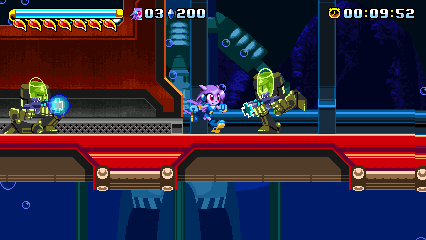
And yet…
Ristar is the definitive Genesis platformer, in my book. It had gorgeous graphics, some of the best use of the Yamaha sound chip, and an sugary-sweet cartoony atmosphere. But its greatest asset was its pacing. Like a good Castlevania or Resident Evil game, everything is painstakingly slow. On paper, this sounds like a horrible idea, but I love this style of “clunk” gameplay when it’s done well. It makes every action require thought, makes every moment suspenseful, makes every choice visceral, and makes every outcome legitimate. It’s important to find the exact speed limit to set for your game when you’re doing this. Ristar hit the limit perfectly. Every action takes far too long and has about twelve frames of excess animation, but it works to the game’s advantage. Everything is an ordeal demanding careful consideration, and the game is mostly about compensating for your inability to do acrobatics over your enemies’ heads. It’s the exact speed a clunk game needs to be at. Freedom Planet is not at this exact speed.
Your standard walking pace is akin more to a jog, unlike Ristar‘s hobbling trudge. You move way too quickly for every action to feel intentional and thought-out. The game feels like it’s trying to go at Sonic speed, but that isn’t conducive to this style of level design. The developers tried to have the best of both worlds here, but they couldn’t manage to bring them successfully together. I’m not convinced anyone could have been able to.
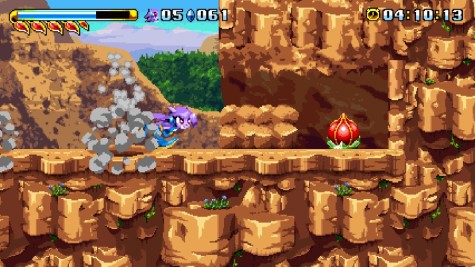
…Holy shit this is the exact same problem Shovel Knight had.
Freedom Planet doesn’t balance its speedier bits with its deliberate pace. The less topographically sound sections are slowed down because the game can’t allow you to move too quickly, and you can’t rocket up ladders or manifest on the other end of monkey bars because your movements are so detailed. Yet combat flies by and can mostly be skimmed over. As with Shovel Knight, enemies that would be troublesome had the game adhered more strongly to a slower game’s sense of slowness are pushovers because you can just jump around them or avoid them entirely. Neither the core of Sonic nor Ristar is preserved here.
The lesson to be learned here is not that the pacing of every game should not be smooth as silk or stumbly as stairs. However, if you’re going to do one heavily, go all out. It’s impossible to have the best of both worlds here. You can have hues of one style in another, but, in trying to include both, you end up with a confused, ugly gray. Each is detrimental to the other. The speediness of Sonic is cancelled out by attempts to be as thoughtful as Ristar. The machinations of Ristar get in the way of the Sonic experience. Freedom Planet fails to understand the dichotomy between these two styles and is too afraid to commit to either one. Ristar and Sonic can’t be in the same room together. It’s why Ristar still isn’t in All-Stars Transformed [citation needed]. When you put them too close together, you get this mess of kinaesthetics.
Part 4: Graphics and Sound
Leonardo da Vinci wrote that perspective “must be preferred to all the discourses and systems of human learning.” In 1981, Jump Bug introduced the first basic parallax scrolling to computer games. The Super Nintendo Entertainment System boasted of its “Mode 7” capabilities in advertising publications, hoping to entice consumers with a stereoscopic effect that could generate apparently three-dimension effects. All of this is to evidence that MAKING YOUR VISUALS APPEAR LAYERED is fucking important, and Freedom Planet‘s lack of concern with it is damaging. The game feels cheap to look at. Only a few areas, namely the end of the Jade Creek stage, boast backgrounds that feel lively. Most are stills with poorly-illustrated foliage and cluttered colors. In the foreground, the boundary between objects is too well-defined. The only shadow in the entire game is the green cat thing. Pay careful attention when your character goes up an incline. She’ll look like she’s running along a one-dimensional line. I mean, I know that’s what they’re actually doing, obviously, but there’s such an obvious break between the characters’ existence and the boundary of the level that it’s jarring. There’s no meniscus to soften the blow of a sudden change in character position. It looks amateurish.
Menus and the like in this game look like they were applied in Paint. They have shadows a mile thick and stick out like a sore thumb against whatever surface they’re applied. Whoever chose this typeface probably uses Chiller. A lot of the text that appears is unnecessary and breaks immersion. I’d assumed we’d gotten away from this kind of nonsense after every Genesis beat-em-up thought it necessary to inform us that we could go — of all directions — right to advance. There are these really distracting caution signs that appear whenever you’re about to get smacked upside the face with a meteor or a missile from off-screen. I’m not complaining that the game actually informs you of incoming hazards

but it is undeniably distracting to have a gigantic, on-the-nose representation of danger clogging up a large portion of the screen.
The voice acting in this game is unprofessional as well. The microphone I use is as good as the ones this game was recorded with, and it costs twenty dollars. Almost none of the lines are delivered well. It’s one of the reasons I turned cutscenes off. This is one of those games where the main character insists on shouting their actions every time they perform them. Every time you double-jump as Ridley, she shouts “Cyclone!” in her twee sixth grader’s voice. No shit you’re double jumping, I’m the one who pushed the button twice. If you wanted to make the main character say something, the least you could’ve done was include more than one line, or hire a better voice actress. I know, this is a nitpick, but it grates on my ears every time.
A lot of people told me the music in this game was really excellent, but I can’t recommend it. It’s really mediocre chiptune, and I can’t remember a single song in the game just like Shovel Knight it’s like that’s a recurring trend. It’s not produced very well, either. Every noise crashes into two or three others on its way to your ear canal. It’s very muddied and confusing. You can hardly make anything out. I avoided praising Shovel Knight for using actual Famicom hardware to produce their music, but I’m starting to long for a soundtrack that used the Genesis’s sound chip.
Everything in Freedom Planet feels like it was made by somebody who wasn’t very seasoned with the technology they were working with. This is plain to see in its graphics and audio, and I think a lot of that lack of experience bleeds through to the rest of the game. I imagine this game looks and sounds as bad as it does because it didn’t have very many resources of the monetary sort to work with, and I get that, but it’s not right to give a game special treatment because it had a handicap.
Part 5: The Level Design
… O. K., I swear I’m not planning this… is anyone else noticing how many of these part headings are analogous to ones from the Shadow Warrior review? I swear, if years from now I have a structural formula to these reviews, somebody has to whack me over the head with an oar.
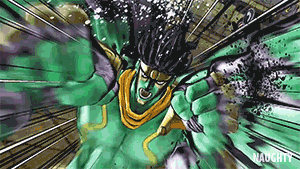
No, I said oar.
Less astute readers will think the comparisons between Sonic and Freedom Planet stem exclusively from the speed of the gameplay. I actually think that it’s closer to Ristar than it is to Sonic. Mechanically, it’s effectively Ristar at double speed .In my opinion, the real comparisons to Sonic come from the level design.
Level design in older Sonic games was excellent. For one, levels were distinct and had their own feel to them. Take the original game as an example: Green Hill Zone is a straightforward level with a few easy-to-access alternate routes to acclimatize the player to the general structure of the game. Marble Zone strips the game of its open, explorative feel and takes players through a claustrophobic series of long corridors. Spring Yard Zone is full of half-pipes and long ramps that make it one of the faster levels in the game. It’s also full of bumpers that create a sense of whimsy.
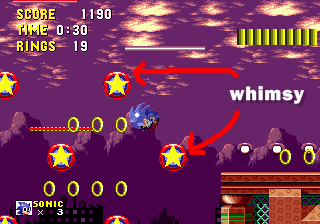
Labyrinth Zone is like Marble Zone, but contains fewer straightaways and more water. Star Light Zone is a laid back, carefree stage with relaxing music. It’s almost as easy as Green Hill Zone. Scrap Brain Zone has an almost oppressive atmosphere complete with a variety of unique obstacles and platforms to overcome. The zone is further divided into a level that emphasizes bottomless pits, a level that emphasizes platforming in small spaces, and a level that’s literally just a harder, graeyer version of Labyrinth Zone. This progression not only gives an ebb and flow to difficulty, making the level more manageable; it gives the next surprise the game has in store a mystique. This also gave the game a perfect balance of exploration, platforming, and speed. Levels like Spring Yard Zone are full of secrets and alternate routes. Levels like Marble Zone have a higher emphasis on precise platforming. Levels like Star Light Zone can be sped through in under five minutes. Most importantly, Sonic has levels with a sensical layout anyone can understand by playing. Every level has major and minor routes, and, especially in Sonic 3, significant, unavoidable gauntlets where the game’s difficulty spikes that give the level an epicenter.
Freedom Planet‘s levels have none of this genius. There’s no difference between the way any of the levels play. They’re all awkwardly paced. You feel as though you’re wandering around looking for the exit. None of the levels are well-defined, so they don’t provide much variety. Speed, as previously established, is difficult to attain at all. Declines steep enough for you to build up speed are sparse, and the game rarely lets you keep momentum for any lengthy period of time. On the rare occasions the game does let you pick up the pace, they’re Sonic-esque sections that require you to hold one direction indefinitely. It’s not challenging or fun when my Page-a-Day calendar can play the game as well as I can.
Exploration is kept to a minimum. There’s hardly anything to discover. In Sonic, a higher path is usually fastest, while lower sections are riskier platforming sections with pits or lava or water. In Freedom Planet, there’s no rhyme or reason to the way any routes play. It’s a total crap shoot, and they all feel about the same to play anyway. There’s hardly any reward the game can give you for discovering secrets, either. Extra lives are arbitrary. Health is plentiful. There are these cards you can pick up scattered through the levels. I haven’t found all of them, but I’m guessing they only exist for an achievement or a “you did it!” sticker. They aren’t hidden lovingly either. I’m not asking for something like Donkey Kong, where every pixel has five secret rooms of its own because that’s excessive. But it would be nice for exploration that felt more like Sonic‘s.
Platforming is far too easy. There isn’t a jump in the game you can’t glaze over through a combination of your jump and double jump (or CYCLONE!, rather). Because you control like a champ, there’s hardly any reason to platform at all. It’s not really melded with the rest of the level, either. In Jade Creek, for instance, there’s a part where you have to avoid these missiles while you run along a submarine. In Sky Battalion, you walk into rooms to discover random “jump-through-these-objects” bits. The game is full of isolated platforming sections like this, and all exploration happens in between. You’re not going to find something surprising as you’re in the middle of a level.
Structurally, these levels are messes compared to Sonic‘s. In Sonic, all the important vegetables are tossed together to create a beautiful salad that sates your curiosity, tactile infatuation, and need for speed constantly. In Freedom Planet, the lettuce, the carrots, and the radishes are all there, but some asshole put in fucking croutons. NO ONE likes croutons. And they didn’t even bother mixing the thing. It’s in isolated layers, so the first person to scoop gets all the carrots and radishes, and the person who goes next has all the dressing that sunk down to the bottom. And it’s not good dressing, either; it’s the kind of dressing that’s way too rich and overpowers the taste of everything else. The kind they make for people who don’t actually like the taste of vegetables, but had doctors tell them they need to lower cholesterol.

Or something.
If there’s one Sonic game Freedom Planet DOES successfully emulate, it’s Sonic CD. It’s a shame CD‘s levels are confusing clusterfucks themselves.

Another ball of Sonic‘s that this game dropped is the environment design. Sonic games had a perfect mix of hard geometries and natural beauty. It actually held some thematic relevance, too. The plot of the games, as most (including myself) often forget, was an ecological fable. The game didn’t damn conservation or industrialization. It asked for harmony between the two. The art design merged these two things together and created locations that were familiar, yet abstract. In Freedom Planet, the environments are all bland. There’s another Chinatown level, a ruins level, a forest level, a shopping mall level, another bamboo forest (it really is the Shadow Warrior review all over again), and a dozen other sorts of levels you’ve seen a dozen times before in Sonic alone. There’s very little creativity to any of these areas.
As a kid, my favorite part of Sonic was getting to explore levels and find out their secrets and being amazed by the platforming challenges and hidden depths the game had. Completing a level was a reward not because of the satisfaction of victory, but because it meant I got to advance and see something new. It meant exploring another creative part of the world. I would draw levels of my own design because they were that imaginative. (I was that big of a nerd.) I never got that in Freedom Planet, and looking back, that was my biggest hope for the game. I wanted to feel like a kid again, and without the quality level design of Sonic, it doesn’t succeed. In that regard, it stands as an immense disappointment.
Part 6: Other Assorted Gripes
So, because I can’t organize for shit, I had a ton of notes on things that I just couldn’t fit into other parts of the review. Because my observations are too valuable to waste, I tossed them together into their own section. This is where things get seriously nitpicky.
Do the little crystals you pick up do anything? I can’t tell. I never saw any opportunity to spend money, so I guess they serve as a score. That makes them kind of arbitrary. They serve the function coins do in Mario and rings do in Sonic, from a level-design standpoint, but there’s no incentive to picking them up. They’re a waste of time. Also: who in their right mind decided how your health bar works? It’s represented in… leaves… and the more damage you take, the fewer eighths of a leaf you’re left with… and each leaf you pick up restores a quarter of a leaf… what!? When was it decided that having a meter was such a bad idea!?
Elemental shields are well-executed in Sonic, because their various benefits are obvious, and I’m glad they’re incorporated here. Unfortunately, they’re rare to come by, and I’m not convinced there’s actually any variety to them. I know the yellow one draws in stamina and health power-ups, and I assume the bubble one lets you breathe underwater, but that’s about all that I’ve figured.
Having total control over a character along the y-axis when swimming is dumb in games. The whole appeal of the platform genre is that gravity itself is your greatest opposition. Being able to best it is freeing at a base level. Giving you complete control over your character’s Cartesian position is dumb and defeating to the purpose of the game. Fewer games should do this. It’s one of the reasons everyone hates underwater levels. Also, drowning takes an hour to actually kick in. By the time the miniscule timer appears above your head, you’ll either miss it because you assumed you can’t drown or will have already passed through the underwater section altogether. The time limit should have been shorter or, ideally, nonexistent.
Lives are totally arbitrary. Continues always plant you right before the place where you died, and you have an infinite amount of them. It’s pointless to even include them, as it is in ninety-nine percent of all games since 2005.
The one great thing I’ll give Freedom Planet? The boss fights. Yep, I’m drawing yet another parallel to Shovel Knight. Every boss fight is among the best I’ve ever seen in a sidescroller, so… all in all, it’s been a pretty good year for platformer bosses. The one gripe with the bosses is the little robotic snake dude, who we’ll call Lyric.You fight him more than once, which, in itself, is a problem if you aren’t a boss rush. It feels like a cop-out to make a player repeat sections of a game, especially bosses. The real issue with him, though, is that he has an attack that will annihilate eighty percent of your health that’s really easy to run into. He doesn’t telegraph it, either, so you can easily slip from attacking him while he’s vulnerable into succumbing to the force of a trillion ionized grapefruits.
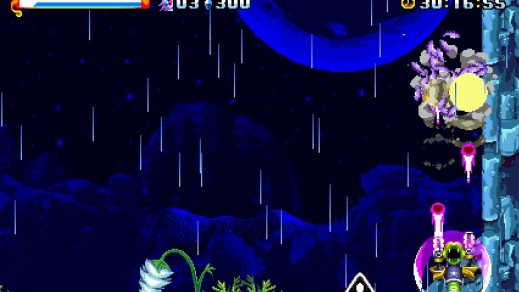
Part 7: Conclusions, or, Big “Buts” That Cannot Lie
Freedom Planet really does feel like a Sonic fan game that turned itself into a fifteen dollar entity, and that isn’t meant to sound enticing. There’s a huge community of Sonic ROM hacks, and only the very best ones manage to scape past “mediocre.” Almost all the assets are stolen from Sonic anyway. In fairness, Freedom Planet does attempt to add some other influences to the game beyond Sonic, but they do little to make it stand out.This is a twenty thousand dollar fan experiment. I hope you’re all happy with it.
…but…
I’d take this game over Shovel Knight any day. Yep, I spent a day writing this review to shit on it, and now I have to admit that the entire thing’s better than another game anyway. Why? Because now I know what the people who made Freedom Planet are like.They’re a ragtag few who decided they wanted to make a video game that reminded them of their childhoods. They wrote an episode of a Saturday morning cartoon and did up some levels that made them reminisce of their favorite games. They like big setpieces and anthropomorphs and radical bosses and Gunstar Heroes and Sparkster and amusement parks and having fun with their games. Shovel Knight was made to be a successful product. Freedom Planet was a labor of love. I have complete faith the people who made this game love it to death, even if I might not. For that, I don’t absolve it from being a “meh” game or a waste of fifteen dollars. I do, however, hold some respect for the game, and I can’t say the same of Shovel Knight. I look forward to what GalaxyTrail does next, and I can see myself really liking their next project. Freedom Planet is full of levity and has real heart and all that other jazz. Here’s hoping we start seeing those more often.
FINAL SCORE: 5.5/10
I might not like this game, but I’m glad Kickstarter gave these guys a chance to Freedom Plan It.
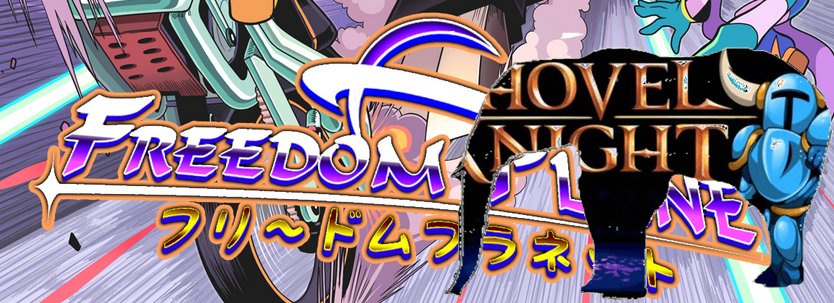
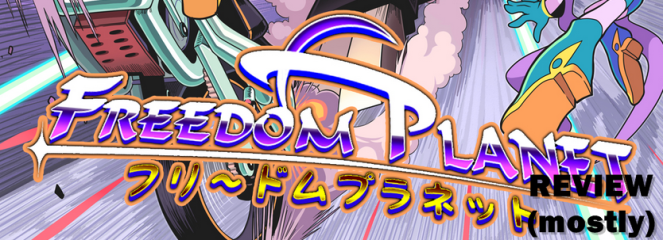
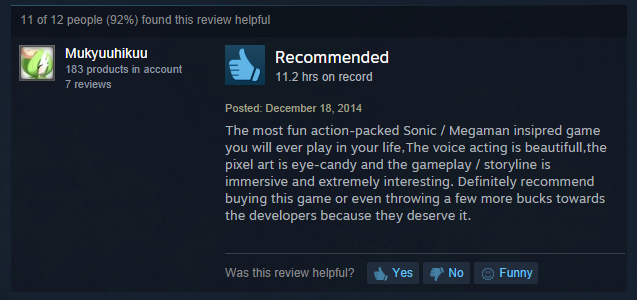
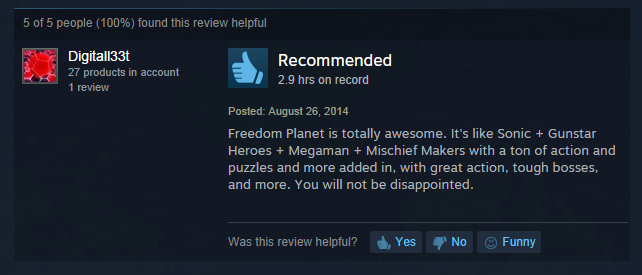

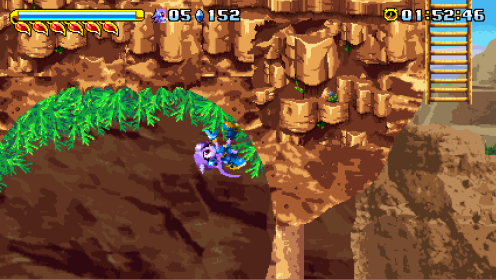

fuck me how much did you write it took me like an hour to fuckign read it im dead good job
LikeLiked by 1 person
you’re sweet :)
LikeLike
I wrote half of it an eternity ago (read: the Shovel Knight part) and the other half + revising was now. In total probably about 8-10 hours. Not too bad, considering.
LikeLiked by 1 person
this was a pretty damn good review, with well thought out and in-depth observations to boot that never seems like a drag to read. not to mention it’s also always fun to see shovel knight kicked around a bit after its vast critical acclaim.
LikeLiked by 1 person
Well, I don’t mean to come across Ben Croshaw-like and be all “SHOVEL KNIGHT IS BAD BECAUSE IT’S POPULAR“, but… it really is bad, and part of that is due to its popularity.
…O. K. maybe not so much “bad” as it is overrated and detrimental to the industry as a whole.
LikeLike
It’s a detail and a well deconstructed review of this popular underrated Indie game. But, you seem to be a bit too harsh, though the game is not bad or terrible. I find the game to be charming in it’s own way. To each of their own, I guess. It’s more of your own personal opinion of Freedom Planet as a whole or something else. I decided to take your review as a grain of salt rather than seriously. Well, you seem to praise official games from official publishers with the exception of Shadow Warrior for the time being and no offense. I’ll wait more of your reviews, they’re a entertaining read. But, Shovel Knight is way more overrated compare to this underdog. As you can see I’m a Sonic and Freedom Planet fan.
Thank you.
Steam: ZanderFox
LikeLike
You kiddin’ me? I just shat on Galaxy 2, the most darling of critical darlings. I wrote the Mario Kart 8 review specifically to bash it. Don’t just a book when you’ve only read four pages. I don’t judge AAA and indie games differently, and there’s a pretty equal helping of each that I enjoy.
Of course a review is a personal opinion! It’s my subjective thoughts on the game. If you want me to agree that it’s an underdog, why not post some things you like about the game?
LikeLike
You got it! I’ll check more of your reviews and read it slowly.
LikeLiked by 1 person
Thanks!
LikeLike
Hi,
Did you finish the game? I thought the drowning time was well tuned for the no-oxygen spaceship level.
LikeLike
I guess I didn’t get far enough for that level.
LikeLike
Freedom Planet is better than Shovel Knight imho.
LikeLike
You’re the only one I’ve ever seen who thinks the same about Shovel Knight that I do…
LikeLike